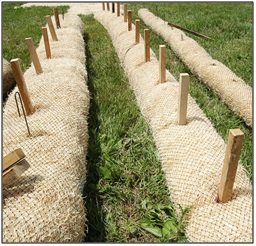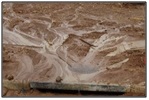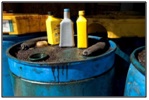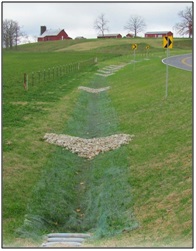Erosion and Sediment Control

Construction activities often involve disturbing soils and the clearing of vegetation. If not handled properly, these activities can result in serious nonpoint source pollution problems such as soil erosion and the deposition of sediment to water bodies, wetlands, and other sensitive areas. Normally, vegetation stabilizes soil so that stormwater is less likely to pick up and transport it to downgradient locations. When vegetation is removed, soil is exposed and can be easily eroded. Runoff from construction sites is by far the largest source of sediment from areas under development. All land clearing activities that disturb more than one acre must obtain a
Construction General Permit from the USEPA.
As described below,
erosion, sedimentation and hazardous materials are the primary concerns related to construction and site development. This section of the Clean Water Toolkit focuses on Best Management Practices (BMPs) for development and construction activities, but you can also find other ways to prevent erosion and sedimentation in the following sections of the Toolkit:
- Urban Stormwater
- Stream Corridor and Shoreline Restoration
- Forestry
- Agriculture
- Roads

Erosion
Pollutants: sediment, nutrients
Erosion is the gradual wearing away of land by water, wind or ice. During construction, land can be disturbed by excavation, filling and paving. This can increase erosion by exposing the soil to stormwater, which picks it up and carries it to another location. Nutrients are also a potential pollution problem associated with erosion, because nutrients such as phosphorus have the ability to cling to eroding sediment particles and can be transported to sensitive downgradient areas (e.g. waterbodies and wetlands).

Sedimentation
Pollutants: sediment, nutrients
Sedimentation is the deposition of particles that have been eroded. After stormwater picks up sediment from a construction site, it has to be deposited somewhere. Sediment that is deposited in a waterbody can impact aquatic habitat and water quality by causing high turbidity, loss of depth, covering of fish spawning areas, and increased algal productivity.

Hazardous Chemicals
Pollutants: pesticides, nutrients, hydrocarbons, toxic substances
In addition to sediments and nutrients, there are a variety of other pollutants associated with construction activities. These substances, which can generate hazardous pollution if they are not handled properly, include pesticides, fertilizers, hydrocarbons (e.g., oils, gasoline, hydraulic fluid) from construction vehicles, toxic construction chemicals such as sealers and paints, and garbage (WSDOE 1991, EPA 1997). Most construction sites also require concrete washouts and adequate containers for waste materials and demolition debris.
Massachusetts Erosion and Sediment Control Resources
Massachusetts Erosion and Sediment Control Regulations
In Massachusetts the local
Conservation Commission typically has jurisdiction over project requirements for erosion and sediment control. Conservation Commissions review projects to ensure they adequately protect Wetlands Resource Areas, as required by the
Massachusetts Wetlands Protection Act.
Standard #8 of the
Massachusetts Stormwater Management Standards states that erosion and sediment controls must be implemented to prevent impacts during construction or land disturbance activities. Project proponents must implement controls that prevent erosion, control sediment movement, and stabilize exposed soils to prevent pollutants from moving off site or entering wetlands or waters. Land disturbance activities include demolition, construction, clearing, excavation, grading, filling, and reconstruction.
The
National Pollutant Discharge Elimination System (NPDES) Stormwater Permit Program requires operators of municipal separate storm sewer systems (MS4s) in urbanized areas and operators of small construction sites, through the use of NPDES permits, to implement programs and practices to control polluted stormwater runoff.
In addition to the above project review processes, any land disturbance greater than one acre requires filing of a
NPDES Construction General Permit to the USEPA Region 1. The general NPDES permit requires that erosion and sediment controls must be used to reduce nonpoint source impacts from construction activities.
Erosion and sediment control requirements for construction projects are also reviewed at the local level by the municipal Planning Board through subdivision rules and the site plan review process.
Best Management Practices for Erosion and Sediment Control

This section provides information on the most common Best Management Practices (BMPs) used to prevent nonpoint source pollution on construction sites. Pollution prevention on construction sites can include stabilizing soils with vegetation or synthetic materials, directing flows away from steep slopes or areas with unstable soil, trapping sediment from flowing water to prevent it from going off site, and generally maintaining an organized and prepared construction site that is in compliance with environmental regulations.
When you are selecting construction-related BMPs, consider these important principles:
- Stabilize soils with vegetation, synthetic products or, if necessary, appropriate chemicals.
- Divert stormwater so it does not come in contact with exposed soil
- Avoid having very steep slopes or other areas of potential high erosion
- Prevent sediment and hazardous materials from going off site
- Have a spill prevention plan
Fact Sheet Links